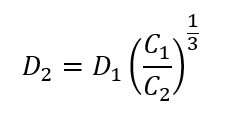Combustible Gas Cloud Concentration with Geographic Mapping
For geographic gas mapping, the concentration of the flammable/combustible gas cloud is assumed to be constant at 100%LFL.
Since the cloud is at the 100% LFL value, if the edge of the cloud touches a point gas detector, it will go into alarm. This will not change if more of the gas cloud passes over the device. The method then will result in the same field-of-influence (FOI) and coverage regardless of the alarm setting of the detector, assuming the gas cloud concentration is above the alarm point. This is different than open-path or beam detectors as they integrate concentration across the distance between the two ends of the device.
For some standards a different concentration value for the gas cloud is needed for the analysis. For these cases, use the below method for converting from a 100% LFL gas cloud into a larger, lower concentration gas cloud, but with the same flammable mass. Starting with the following equation:

where C1 is the current concentration, D1 is the diameter of the current gas cloud, C2 is the concentration desired and D 2 is the diameter of the resulting gas cloud size.
Solving for D2 we have the following equation:

So, if we say that the 100% LFL cloud is at 5 meters, the 50% LFL cloud we would perform the following calculation:

resulting in D2 being 6.3 meters.
Doing the same for a 20% LFL cloud would result in 8.5 meters
With this information, you can set up risk grades with gas cloud sizes equal to 6.3 and 8.5 meters representing 50%LFL and 20%LFL concentrations. You can then calculate the coverage for the different concentrations.
Toxic Gas Clouds
Normally, the above correlation is for combustible gas mapping only. The reason is that the volume of a flammable gas cloud has a direct correlation to the explosion consequence, whereas the link with volume is not at all clear for toxic gas clouds, where the absolute concentration is much more important than its volume.
For example, the justification of scaling the flammable gas cloud is that the volume is calculated by adjusting the concentration but keeping the flammable mass the same. The assumption is that two gas clouds with the same flammable mass have the same consequence regardless of their concentration. This may or may not be reasonable, but it at least provides a reasoned argument for the scaling. But for toxic gas clouds, this type of scaling isn’t really true – a larger gas cloud at a lower concentration may have a much larger consequence than a smaller gas cloud at a higher concentration. So there isn’t the same reasoned argument to justify the scaling described above.